Vietnam Veterans Memorial
| Vietnam Veterans Memorial | |
|---|---|
|
IUCN category V (protected landscape/seascape) | |
|
Visitors at the wall in January 2005. | |
 | |
| Location | Washington, D.C., United States |
| Coordinates | 38°53′28″N 77°2′52″W / 38.89111°N 77.04778°WCoordinates: 38°53′28″N 77°2′52″W / 38.89111°N 77.04778°W |
| Area | 2.00 acres (0.81 ha) |
| Established | November 13, 1982 |
| Visitors | 3,799,968 (in 2006) |
| Governing body | National Park Service |
| Website | |
| Architect | Maya Lin |
| NRHP Reference # | 01000285[1] |
| Added to NRHP | November 13, 1982 |
The Vietnam Veterans Memorial is a 2-acre (8,000 m²) national memorial in Washington, DC. It honors U.S. service members of the U.S. armed forces who fought in the Vietnam War, service members who died in service in Vietnam/South East Asia, and those service members who were unaccounted for (Missing In Action) during the War.
Its construction and related issues have been the source of controversies, some of which have resulted in additions to the memorial complex. The memorial currently consists of three separate parts: the Three Servicemen Memorial, the Vietnam Women's Memorial, and the Vietnam Veterans Memorial Wall, which is the best-known part of the memorial.
The main part of the memorial, which was completed in 1982, is in Constitution Gardens adjacent to the National Mall, just northeast of the Lincoln Memorial. The memorial is maintained by the U.S. National Park Service, and receives around 3 million visitors each year. The Memorial Wall was designed by American architect Maya Lin. In 2007, it was ranked tenth on the "List of America's Favorite Architecture" by the American Institute of Architects. As a National Memorial it is listed on the National Register of Historic Places.
Appearance

Memorial Wall
The Memorial Wall is made up of two 246 feet 9 inches (75.21 m) long gabbro walls, etched with the names of the servicemen being honored in panels of horizontal rows with regular typeface and spacing.[2][3] The walls are sunk into the ground, with the earth behind them. At the highest tip (the apex where they meet), they are 10.1 feet (3.1 m) high, and they taper to a height of 8 inches (20 cm) at their extremities. Symbolically, this is described as a "wound that is closed and healing."
When a visitor looks upon the wall, his or her reflection can be seen simultaneously with the engraved names, which is meant to symbolically bring the past and present together. One wall points toward the Washington Monument, the other in the direction of the Lincoln Memorial, meeting at an angle of 125° 12′. Each wall has 72 panels, 70 listing names (numbered 1E through 70E and 70W through 1W) and 2 very small blank panels at the extremities. There is a pathway along the base of the Wall, where visitors may walk.
The wall listed 58,191 names when it was completed in 1983; as of May 2015, there are exactly 58,307 names, including 8 women. Approximately 1,200 of these are listed as missing (MIAs, POWs, and others). Directories are located on nearby podiums so that visitors may locate specific names.
Names
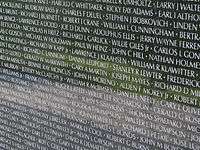
On the walls are the names of servicemen classified as KIA (Killed in Action), or MIA (Missing in Action) when the walls were constructed. The names are inscribed in Optima typeface. Information about rank, unit, and decorations is not given.
Those who died in action are denoted by a diamond, those who were missing (MIAs, POWs, and others) are denoted with a cross. When the death of one who was previously missing is confirmed, a diamond is superimposed over the cross. If the missing were to return alive, which has never occurred to date, the cross is to be circumscribed by a circle.
The names are listed in chronological order, starting at the apex on panel 1E in 1959 (although it was later discovered that the first casualties were military advisers who were killed by artillery fire in 1957), moving day by day to the end of the eastern wall at panel 70E, which ended on May 25, 1968, starting again at panel 70W at the end of the western wall which completes the list for May 25, 1968, and returning to the apex at panel 1W in 1975.
According to the Vietnam Veterans Memorial Fund, "there is no definitive answer to exactly how many, but there could be as many as 38 names of personnel who survived, but through clerical errors, were added to the list of fatalities provided by the Department of Defense."[4]
The Three Servicemen
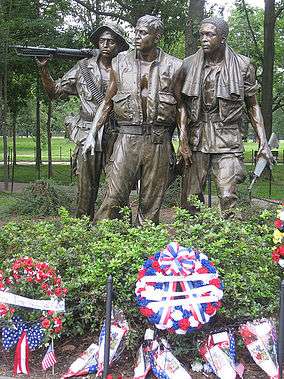
A short distance away from the wall is another Vietnam memorial, a bronze statue named The Three Servicemen (sometimes called The Three Soldiers). The statue depicts three soldiers, purposefully identifiable as European American, African American, and Hispanic American. In their final arrangement, the statue and the Wall appear to interact with each other, with the soldiers looking on in solemn tribute at the names of their fallen comrades. The distance between the two allows them to interact while minimizing the effect of the addition on Lin's design.
Women's Memorial
The Vietnam Women's Memorial is a memorial dedicated to the women of the United States who served in the Vietnam War, most of whom were nurses. It serves as a reminder of the importance of women in the conflict. It depicts three uniformed women with a wounded soldier. It is part of the Vietnam Veterans Memorial, and is located on National Mall in Washington D.C., a short distance south of The Wall, north of the Reflecting Pool.
In Memory memorial plaque
A memorial plaque, authorized by Pub.L. 106–214, was dedicated on November 10, 2004, at the northeast corner of the plaza surrounding the Three Soldiers statue to honor veterans who died after the war as a direct result of injuries suffered in Vietnam, but who fall outside Department of Defense guidelines. The plaque is a carved block of black granite, 3 by 2 feet (0.91 by 0.61 m), inscribed "In memory of the men and women who served in the Vietnam War and later died as a result of their service. We honor and remember their sacrifice."
Ruth Coder Fitzgerald, founder of The Vietnam War In Memory Memorial Plaque Project, worked for years and struggled against opposition to have the In Memory Memorial Plaque completed. The organization was disbanded, but their web site is maintained by the Vietnam War Project at Texas Tech University.
Ritual
Visitors to the Wall will take a piece of paper and place it over a name on the wall and rub wax crayon or graphite pencil over it as a memento of their loved ones. This is called "rubbing".
Visitors to the memorial began leaving sentimental items at the memorial at its opening. One story claims that this practice began during construction, when a Vietnam veteran threw the Purple Heart his brother received posthumously into the concrete of the memorial's foundation.[5] Several thousand items are left at the memorial each year. The largest item left at the memorial was a sliding glass storm door with a full-size replica "tiger cage". The door was painted with a scene in Vietnam and the names of U.S. POWs and MIAs from the conflict.[5] Other items left include a Harley-Davidson motorcycle with the license plate HERO, a plain brown teddy bear which was dressed by other unconnected visitors, a 6' abstract sculpture titled "After the Holocaust", and an experimental W. R. Case "jungle survival knife" of which only 144 were made.
History
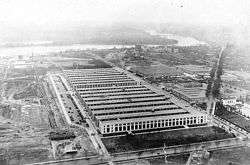
In April 27, 1979, four years after the Fall of Saigon, The Vietnam Veterans Memorial Fund, Inc. (VVMF), was incorporated as a non-profit organization to establish a memorial to veterans of the Vietnam War. Much of the impetus behind the formation of the fund came from a wounded Vietnam veteran, Jan Scruggs, who was inspired by the film The Deer Hunter, with support from fellow Vietnam veterans such as retired Navy chaplain Arnold Resnicoff. Eventually, $8.4 million was raised by private donations.
A year later a site near the Lincoln Memorial was chosen and authorized by Congress on the site of a demolished World War I Munitions Building. Congress announced that the winner of a design competition will design the park. By the end of the year 2,573 registered for the design competition with a prize of $20,000. On March 30, 1981, 1,421 designs were submitted. The designs were displayed at an airport hangar at Andrews Air Force Base for the selection committee, in rows covering more than 35,000 square feet (3,300 m2) of floor space. Each entry was identified by number only, to preserve the anonymity of their authors. All entries were examined by each juror; the entries were narrowed down to 232, then 39. Finally, the jury selected entry number 1026. The artist was Maya Lin.
Opposition to design & compromise
The selected design was very controversial, in particular its unconventional design, its black color and its lack of ornamentation.[6] Some public officials voiced their displeasure, calling the wall "a black gash of shame."[7] Two prominent early supporters of the project, H. Ross Perot and James Webb, withdrew their support once they saw the design. Said Webb, “I never in my wildest dreams imagined such a nihilistic slab of stone.” James Watt, Secretary of the Interior under President Ronald Reagan, initially refused to issue a building permit for the memorial due to the public outcry about the design.[8] Since its early years, criticism of the Memorial's design faded. In the words of Scruggs, "It has become something of a shrine."[7]
Negative reactions to Lin's design created a controversy; a compromise was reached by commissioning Frederick Hart (who had placed third in the original design competition) to produce a bronze figurative sculpture in the heroic tradition. Opponents of Lin's design had hoped to place this sculpture of three soldiers at the apex of the wall's two sides. Lin objected strenuously to this, arguing that this would make the soldiers the focal point of the memorial, and her wall a mere backdrop. A compromise was reached, and the sculpture was placed off to one side to minimize the impact of the addition on Lin's design. On October 13, 1982 the U.S. Commission of Fine Arts approved the erection of a flagpole to be grouped with sculptures.
Building the memorial
On March 11, 1982, the revised design was formally approved, and on March 26, 1982, ground was formally broken. Stone for the wall came from Bangalore, Karnataka, India, and was deliberately chosen because of its reflective quality. Stone cutting and fabrication was done in Barre, Vermont. The typesetting of the original 58,195 names on the wall was performed by Datalantic in Atlanta, Georgia. Stones were then shipped to Memphis, Tennessee where the names were etched. The etching was completed using a photoemulsion and sandblasting process. The negatives used in the process are in storage at the Smithsonian Institution.
The memorial was dedicated on November 13, 1982, after a march to its site by thousands of Vietnam War veterans. About two years later the Three Soldiers statue was dedicated.
Timeline for those listed on the wall
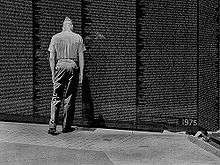
- November 1, 1955 – Dwight D. Eisenhower deployed the Military Assistance Advisory Group, referred to now as MAAG, to train the South Vietnamese military units and secret police. However, the U.S. Department of Defense does not recognize this date since the men were supposedly only training the Vietnamese, so the officially recognized date is the formation of the Military Assistance Command Viet Nam, better known as MACV. This marked the official beginning of American involvement in the war as recognized by the memorial.
- June 8, 1956 – The first official death in Vietnam was United States Air Force Technical Sergeant Richard Bernard Fitzgibbon, Jr. of Stoneham, Massachusetts who was murdered by another U.S.A.F. airman.
- July 8, 1959 – Chester M. Ovnand and Dale R. Buis were killed by guerrillas at Bien Hoa while watching the film The Tattered Dress. They are listed Nos. 1 and 2 at the wall's dedication. Ovnand's name is spelled on the memorial as "Ovnard," due to conflicting military records of his surname.
- April 30, 1975 – Fall of Saigon. The U.S. Department of Veterans Affairs uses May 7, 1975 as the official end date for the Vietnam War era as defined by 38 U.S.C. § 101.
- May 15, 1975 – 18 U.S. servicemen (14 Marines, two Navy corpsmen, and two Air Force crewmen) are killed on the last day of a rescue operation known as the Mayagüez incident with troops from the Khmer Rouge in Cambodia. They are the last servicemen listed on the timeline.
- May 4, 2010 – Six names were added to the Vietnam Veterans Memorial during a ceremony. The new names are veterans who died after the war as a direct result of injuries suffered in the combat zone.[9]
Addition of the Women's memorial
The Women's memorial was designed by Glenna Goodacre for the women of the United States who served in the Vietnam War. The original winning entry of the Women's Memorial design contest was deemed unsuitable. Glenna Goodacre's entry received an honorable mention in the contest and she was asked to submit a modified maquette (design model). Goodacre's original design for the Women's Memorial statue included a standing figure of a nurse holding a Vietnamese baby, which although not intended as such, was deemed a political statement, and it was asked that this be removed. She replaced them with a figure of a kneeling woman holding an empty helmet. On November 11, 1993 the Vietnam Women's Memorial was dedicated. There is a smaller replica of that memorial at Vietnam Veterans Memorial State Park in Angel Fire, New Mexico.
Memorial plaque
On November 10, 2000, a memorial plaque, authorized by Pub.L. 106–214, honoring veterans who died after the war as a direct result of injuries suffered in Vietnam, but who fall outside Department of Defense guidelines was dedicated. Ruth Coder Fitzgerald, founder of The Vietnam War In Memory Memorial Plaque Project, worked for years and struggled against opposition to have the In Memory Memorial Plaque completed. The organization was disbanded, but their web site is maintained by the Vietnam War Project at Texas Tech University.
Vietnam Veterans Memorial Collection

Items left at the Vietnam Veterans Memorial are collected by National Park Service employees and transferred to the NPS Museum Resource Center, which catalogs and stores all items except perishable organic matter (such as fresh flowers) and unaltered U.S. flags. The flags are redistributed through various channels.[10]
From 1992 to 2003, selected items from the collection were placed on exhibit, at the Smithsonian Institution's National Museum of American History as "Personal Legacy: The Healing of a Nation" including the Medal of Honor of Charles Liteky, who renounced it in 1986 by placing the medal at the memorial in an envelope addressed to then-President Ronald Reagan.
Inspired works
Traveling replicas
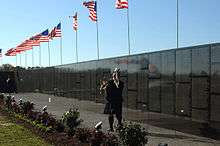
There are several transportable replicas of the Vietnam Veteran's Memorial created so those who are not able to travel to Washington, D.C. would be able to simulate an experience of visiting the Wall.
- Using personal finances, John Devitt founded Vietnam Combat Veterans, Ltd. With the help of friends, the half-size replica of the Vietnam Veterans Memorial, named The Moving Wall,[11] was built and first put on display to the public in Tyler, Texas, in 1984. The Moving Wall visits hundreds of small towns and cities throughout the U.S., staying five or six days at each site. Local arrangements for each visit are made months in advance by veterans' organizations and other civic groups. Desire for a hometown visit of The Moving Wall was so high that the waiting list became very long. Vietnam Combat Veterans built a second structure of The Moving Wall. A third structure was added in 1989. In 2001, one of the structures was retired due to wear. By 2006, there had been more than 1,000 hometown visits of The Moving Wall. The count of people who visited The Moving Wall at each display ranges from 5,000 to more than 50,000; the total estimate of visitors is in the tens of millions. As the wall moves from town to town on interstates, it is often escorted by state troopers and up to thousands of local citizens on motorcycles. Many of these are Patriot Guard Riders, who consider escorting The Moving Wall to be a "special mission", which is coordinated on their website. As it passes towns, even when it is not planning a stop in those towns, local veterans organizations sometimes plan for local citizens to gather by the highway and across overpasses to wave flags and salute the Wall.[11]
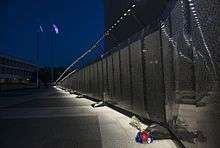
- The Wall That Heals is a traveling half-scale replica of the Vietnam Veterans Memorial started in 1996 by the Vietnam Veterans Memorial Fund. A 53-foot (16 m) tractor-trailer transports the 250-foot (76 m) wall replica and converts to a mobile Education Center at each stop, showing letters and memorabilia left at The Wall in Washington, D.C. and more details about those whose names are shown. This half-scale replica has been retired to permanent display in front of the James E. Van Zandt VA Medical Center in Altoona, PA. The VVMF has resumed a half-scale replica touring throughout the U. S. of The Wall That Heals. Their 2015 schedule can be found at www.vvmf.org/twth
- Created by the American Veterans Traveling Tribute, The Traveling Wall is an 80% replica Vietnam Veterans Memorial Wall and is 360 feet (110 m) long and 8 feet (2.4 m) tall at its apex. It claims to be the largest traveling replica.
- Created by Vietnam and All Veterans of Brevard, Inc, The Vietnam Traveling Memorial Wall is a 3⁄5 scale of the Vietnam Veterans Memorial and is almost 300 feet (91 m) long and 6 feet (1.8 m) tall at the center.
- Created by Dignity Memorial, the Dignity Memorial Vietnam Wall is 3⁄4 scale of the Vietnam Veterans Memorial.
Fixed replicas
Located at 200 S. 9th Ave in Pensacola, FL the first permanent replica of the National Vietnam Memorial was unveiled on October 24, 1992. Now known as "Wall South," the half-size replica bears the names of all Americans killed or missing in Southeast Asia and is updated each Mother's Day. It is the centerpiece of Veterans Memorial Park Pensacola, a five-and-one-half acre site overlooking Pensacola Bay, which also includes a World War I Memorial, a World War II Memorial, a Korean War Memorial, a Revolutionary War Memorial and a running series of plaques to honor local warriors who have fallen in the Global War on Terror.[12] There is also a Purple Heart Memorial, a Marine Corps Aviation Bell Tower and a monument to the submarine lifeguards who rescued Navy pilots in World War II. A Global War on Terror Memorial is planned to be completed in 2017 and will include an artifact from the World Trade Center as a component of the sculpture.[13]
Located in Fox Park in Wildwood, New Jersey, The Wildwoods Vietnam Memorial Wall was unveiled and dedicated on May 29, 2010. The memorial wall is an almost half-size granite replica of the National Vietnam Memorial, and the only permanent memorial north of the nation's capital.[14]
Located 401 East Ninth Street in Winfield, Kansas. Plans for the Vietnam War Memorial in Winfield began in 1987 when friends who had gathered for a class reunion wanted to find a way to honor their fallen classmates. The project quickly grew from honoring only Cowley County servicemen to representing all 777 servicemen and nurses from Kansas who lost their lives or are missing in action from the Vietnam War. The memorial is a replica of the Vietnam War memorial in Washington D.C. It was also created as a tribute to servicemen and nurses who served in any world war.[15]
As a Memorial Genre
The first US memorial to an ongoing war, the Northwood Gratitude and Honor Memorial in Irvine, California, is modelled on the Vietnam Veterans memorial in that it includes a chronological list of the dead engraved in dark granite. As the memorialized wars (in Iraq and Afghanistan) have not concluded, the Northwood Gratitude and Honor Memorial will be updated yearly. It has space for about 8000 names, of which 5,714 were engraved as of the Dedication of the Memorial on November 14, 2010.[16][17]
Vandalism
There have been three known incidents of vandalism at the memorial wall.
- The first occurred in April 1988, when a swastika and various scratches were found etched in two of the panels.[18] The panels were replaced.
- In 1993, someone burned one of the directory stands at the entrance to the memorial.[19]
- On September 7, 2007, an oily substance was found by park rangers on the memorial's wall panels and paving stones. It was spread over an area of 50 to 60 feet (18 m). Memorial Fund founder Jan Scruggs deplored the scene, calling it an "act of vandalism on one of America's sacred places". The removal process took a few weeks to complete.[19]
See also

- Vietnam War Memorial, Hanoi
- Vietnam Forces National Memorial, Canberra
- Vietnam Veterans Memorial (The Wall-USA), an online memorial
- Vietnam Veterans of America, chartered by Congress and campaigns on issues important to Vietnam veterans
- The Virtual Wall, an online memorial
- The Wall That Heals, a 1997 film
- s:Maya Lin's original competition submission for the Vietnam Veterans Memorial
- Northwood Gratitude and Honor Memorial
- Korean War Veterans Memorial
- National World War II Memorial
- Japanese American Memorial to Patriotism During World War II* List of public art in Washington, D.C., Ward 2
References
Footnotes
- ↑ National Park Service (July 9, 2010). "National Register Information System". National Register of Historic Places. National Park Service.
- ↑ Robbins, Eleanora I. (2001). Building Stones and Geomorphology of Washington, D.C.: The Jim O’Connor Memorial Field Trip. CiteSeerX 10.1.1.124.7887
 .
. - ↑ Rasmussen, Kenneth (October 16, 2010). "The Post Could Have Better Explained Cracks in the Wall". Opinions. The Washington Post (Letter to the Editor). Retrieved October 16, 2010.
- ↑ "Vietnam Memorial Fund: FAQs". Archived from the original on April 5, 2012.
- 1 2 "MRCE: Frequently Asked Questions (continued)". National Park Service. Retrieved June 21, 2010.
- ↑ Vietnam Veterans' Memorial Founder: Monument Almost Never Got Built
- 1 2 Garber, Kent (November 3, 2007). "A Milestone for a Memorial that Has Touched Millions". U.S. News and World Report. Retrieved November 11, 2009.
- ↑ Wills, Denise (November 1, 2007). "The Vietnam Memorial's History". The Washingtonian. Retrieved November 11, 2009.
- ↑ "Six Names Added to Vietnam Veterans Memorial". American Forces Press Service.
- ↑ "MRCE: Frequently Asked Questions". National Park Service. Retrieved June 21, 2010.
- 1 2 "Local AMVETS to Salute Wall". Greenville Advocate. July 17, 2007.
- ↑ Giberson, Art (2015). Wall South: Veterans Memorial Park. Pensacola, FL: CreateSpace.
- ↑ "Veterans Memorial Park Pensacola". Veterans Memorial Park Foundation.
- ↑ "The Wildwoods Vietnam Memorial Wall". Wildwood, NJ.
- ↑ "Kansas Vietnam War Memorial". Winfield, KS.
- ↑ "The Northwood Gratitude and Honor Memorial". northwoodmemorial.com.
- ↑ Kang, Sukhee (February 22, 2010). "Letter". City of Irvine. Retrieved June 21, 2010.
- ↑ "Vandals Scratch Swastika on Face of Viet Veterans Memorial". Los Angeles Times. United Press International. May 3, 1988.
- 1 2 "Substance on Vietnam Memorial is Vandalism". Oswego, NY: WTOP-TV. Retrieved September 2, 2010..
Works cited
- Vietnam Veterans Memorial (Leaflet). National Park Service. GPO:2004—304–377/00203.
- The National Parks: Index 2001–2003. Washington: United States Department of the Interior.
Further reading
- Ashabranner, Brent K. (1989). Always to Remember: The Story of the Vietnam Veterans Memorial. New York: Putnam.
- ——— (1998). Their Names to Live: What the Vietnam Veterans Memorial Means to America. Brookfield, CT: Twenty-first Century Press.
- Berdahl, Daphne. "Voices at the Wall: Discourses of Self, History and National Identity at the Vietnam Veterans Memorial". History & Memory: Studies in Representation of the Past. 6 (Fall–Winter 1994): 88–124.
- Blair, Carole; Jeppeson, Marsha S. & Pucci, Enrico, Jr. (August 1991). "Public Memorializing in Postmodernity: The Vietnam Veterans Memorial as Prototype". Quarterly Journal of Speech. 77: 263–288. doi:10.1080/00335639109383960.
- Capasso, Nicholas (1998). The National Vietnam Veterans Memorial in Context: Commemorative Public Art in America, 1960–1997 (PhD Thesis). Rutgers University.
- Carlson, A. Cheree & Hocking, John E. (September 1988). "Strategies of Redemption at the Vietnam Veterans Memorial". Western Journal of Speech Communication. 52: 203–215. doi:10.1080/10570318809389636.
- Carney, Lora S. (1993). "Not Telling Us What to Think: The Vietnam Veterans Memorial". Metaphor and Symbolic Activity. 8 (3): 211–219. doi:10.1207/s15327868ms0803_6.
- Danto, Arthur (August 31, 1985). "The Vietnam Veterans Memorial". The Nation. pp. 152–155.
- Ellis, Caron S. (Summer 1992). "So Old Soldiers Don't Fade Away: The Vietnam Veterans Memorial". Journal of American Culture. 15: 25–28. doi:10.1111/j.1542-734x.1992.t01-1-00025.x.
- Ehrenhaus, Peter (March 1988). "Silence and Symbolic Expression". Communication Monographs. 55: 41–57. doi:10.1080/03637758809376157.
- Foss, Sonja K. (Summer 1986). "Ambiguity as Persuasion: The Vietnam Veterans Memorial". Communication Quarterly. 34: 326–340. doi:10.1080/01463378609369643.
- Friedman, Daniel S. (November 1995). "Public Things in the Modern City: Belated Notes on Tilted Arc and the Vietnam Veterans Memorial". JAE: Journal of Architectural Education. 49: 62–78. doi:10.1080/10464883.1995.10734669.
- Giberson, Art (2015). Wall South: Veterans Memorial Park. Pensacola, FL: CreateSpace.
- Griswold, Charles L. (Summer 1986). "The Vietnam Veterans Memorial and the Washington Mall: Philosophical Thoughts on Political Iconography". Critical Inquiry. 12: 688–719. doi:10.1086/448361.
- Haines, Harry (1986). "'What Kind of War?': An Analysis of the Vietnam Veterans Memorial". Critical Studies in Mass Communucation. 3: 1–20. doi:10.1080/15295038609366626.
- Hass, Kristin Ann (1998). Carried to the Wall: American Memory and the Vietnam Veterans Memorial. Berkeley: University of California Press.
- Hass, Kristin Ann (2015). Sacrificing Soldiers on the National Mall. Berkeley, CA: University of California Press.
- Hess, Elizabeth (1987). "Vietnam: Memorials of Misfortune". In Williams, Reese. Unwinding the Vietnam War: From War into Peace. Seattle: Real Comet Press. pp. 261–270.
- Hubbard, William (Winter 1984). "A Meaning for Monuments". The Public Interest. 74: 17–30.
- Katakis, Michael (1988). The Vietnam Veterans Memorial. New York: Crown.
- Lopes, Sal (1987). The Wall: Images and Offerings from the Vietnam Veterans Memorial. New York: Collins.
- McLeod, Mary (1989). "The Battle for the Monument: The Vietnam Veterans Memorial". In Lipstadt, Helene. The Experimental Tradition. New York: Rizzoli. pp. 115–137.
- Morrissey, Thomas F. (2000). Between the Lines: Photographs from the National Vietnam Veterans Memorial. Syracuse, NY: Syracuse University Press.
- Ochsner, Jeffrey Karl (February 1997). "A Space of Loss: The Vietnam Veterans Memorial". JAE: Journal of Architectural Education. 50: 156–171. doi:10.1080/10464883.1997.10734719.
- Palmer, Laura (1987). Shrapnel in the Heart: Letters and Remembrances from the Vietnam Veterans Memorial. New York: Random House.
- Resnicoff, Arnold E. (2009). "Dedication Prayer for the Vietnam Veterans Memorial". In Moore, James P., Jr. The Treasury of American Prayer. Doubleday. p. 317.
- Scott, Grant F. (Fall 1990). "Meditations in Black: The Vietnam Veterans Memorial". Journal of American Culture. 13: 37–40. doi:10.1111/j.1542-734x.1990.1303_37.x.
- Scruggs, Jan C. & Swerdlow, Joel L. (1985). To Heal a Nation: The Vietnam Veterans Memorial. New York: Harper & Row.
- Sturken, Marita (Summer 1991). "The Wall, the Screen, and the Image: The Vietnam Veterans Memorial". Representations. 35: 118–142. doi:10.1525/rep.1991.35.1.99p00683.
- Wagner-Pacific, Robin & Schwartz, Barry (1991). "The Vietnam Veterans Memorial: Commemorating a Difficult Past". The American Journal of Sociology. 97: 376–420. doi:10.1086/229783.
External links
| Wikimedia Commons has media related to Vietnam Veterans Memorial. |
| Wikisource has original text related to this article: |
- "Tenth Anniversary Commemoration". C-SPAN. 11 November 1992. Retrieved 29 May 2015.
A number of dignitaries spoke at a ceremony marking the tenth anniversary of the Vietnam Veterans Memorial on a rainy day in Washington, DC. The keynote speakers, former Lebanese hostage Terry Anderson and Vice President-elect Al Gore, Jr., honored the Vietnam veterans living and dead for their service to their country. Sen. Gore also pledged to investigate every POW and MIA from the Vietnam War, and also improve the veterans health care system. Following the speeches, Sen. Gore and Mr. Scruggs placed a wreath at the base of the Vietnam Veterans Memorial, and a lone bugle player played 'Taps'.
